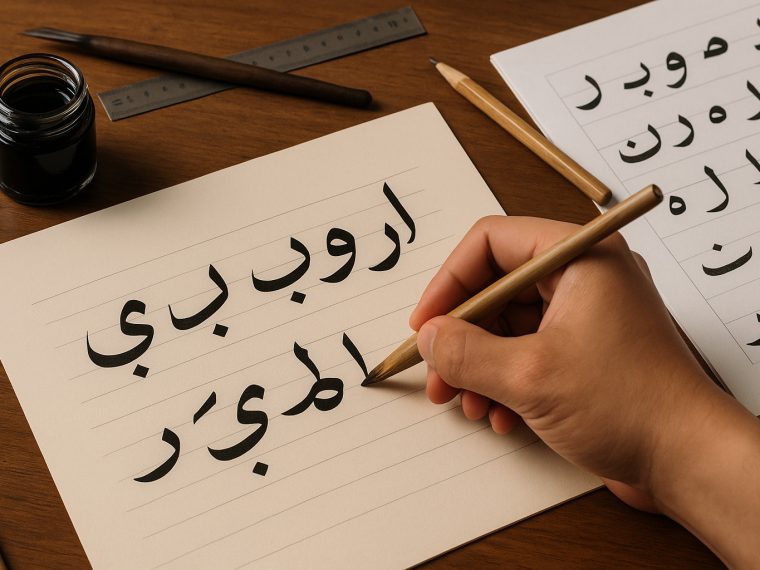Malay calligraphy, also known as Khat Melayu, blends Islamic art, Southeast Asian aesthetics, and centuries of tradition. If you’re curious about how to start, what tools to use, and the best approach to learning this art form, this guide strips it to the essentials without overwhelming you.
What Is Malay Calligraphy?
Malay calligraphy refers to stylized writing based on Arabic script used in the Malay language. It often appears in religious texts, historical manuscripts, and cultural motifs. The most common script styles include Jawi, Kufi, and Thuluth, each with its own character and application.
- Jawi: Adapted Arabic script for writing Malay, used in royal edicts and literature.
- Kufi: Block-like, geometric script often used in architecture.
- Thuluth: Curved and elongated, typically used for decorative and ceremonial purposes.
Calligraphy is more than handwriting. It’s structured, rhythmic, and intentional. Every letter has proportion and placement rules.
Why Learn Malay Calligraphy?
- It connects you with Malay literary history.
- It encourages patience, precision, and visual discipline.
- It opens a path to Islamic art forms deeply tied to spiritual expression.
Basic Tools You’ll Need
Starting doesn’t require expensive tools. Focus on quality over quantity. Here’s a short list to get going:
Writing Tools
- Qalam: Traditional reed pen cut at an angle. Creates thick and thin lines with fluidity.
- Brush Pens: Flexible tip pens used for practice and modern adaptations.
- Dip Pens: More precise control and variation, especially with ink-based scripts.
Ink
- Black Calligraphy Ink: Deep black, non-bleeding, and slow-drying is preferred.
- Colored Ink: Occasionally used in decorations, but not ideal for beginners.
Paper
- Smooth Paper: Calligraphy ink glides better without fraying nibs.
- Grid or Lined Paper: Helps with consistent size and proportion, especially during early training.
Ruler and Pencil
- Used for creating baselines, margins, and character guides. Always sketch lightly.
Basic Concepts You Must Know
Before forming full words, get familiar with basic strokes and shapes. Here’s what you’ll encounter:
- Harf (Letters): Arabic letters form the core of Malay calligraphy.
- Nisbah (Proportions): Letter height, angle, and width must follow specific ratios.
- Khattat (Calligrapher): A student must copy the master’s work repeatedly before finding their own style.
How to Start Practicing
You can’t rush through calligraphy. Each stroke matters. Follow this step-by-step structure to avoid frustration.
1. Choose a Script Style
Start with Jawi. It’s practical, readable, and has immediate use in Malay texts. Avoid ornate styles like Diwani or Thuluth until you build muscle memory.
2. Master Letter Forms
Use worksheets or reference guides. Practice each letter in isolation:
- Trace over printed samples using a lightbox or thin paper.
- Repeat each letter 20–30 times.
- Focus on consistency in height, thickness, and angles.
3. Practice Joining Letters
Malay calligraphy relies heavily on ligatures (connected letters). The way letters combine affects spacing, alignment, and rhythm.
- Learn initial, medial, and final forms of each letter.
- Practice with common syllables like ka, ba, ra, ta.
4. Write Full Words
Once basic connections feel natural, start forming complete words. Begin with simple, symmetrical ones such as buku, kata, or jalan.
- Write each word repeatedly with focus on uniformity.
- Check balance across the baseline and ascenders/descenders.
5. Apply Diacritical Marks
Jawi uses vowel marks to indicate pronunciation. These dots and dashes, though small, carry meaning. Add them only after mastering the base letters.
Common Mistakes and How to Avoid Them
Avoiding foundational errors will save time and frustration:
- Skipping Proportions: Calligraphy isn’t freeform. Each letter must respect width-to-height rules.
- Over-Inking: Too much ink leads to bleeding. Dip lightly, wipe excess, and test strokes first.
- Wrong Paper: Rough paper ruins pen tips and absorbs ink unevenly.
- No Guide Lines: Always draw light pencil baselines and x-heights.
Learning Sources Worth Your Time
While self-practice helps, feedback and structured training speed up progress.
- Books: Look for Jawi calligraphy manuals with visual samples.
- Workshops: Cultural centers or Islamic art hubs often offer beginner sessions.
- YouTube Channels: Some master calligraphers provide slow, close-up tutorials for free.
- Online Courses: Consider beginner modules from reputable Islamic art institutions.
Tips for Long-Term Progress
Calligraphy requires sustained, mindful effort. Here’s how to maintain momentum:
- Daily Practice: 15 minutes a day yields better results than once-a-week marathons.
- Compare to Masters: Lay your work side-by-side with traditional pieces to spot gaps.
- Join Calligraphy Groups: Share progress, ask questions, and stay motivated.
Cultural Etiquette in Malay Calligraphy
Calligraphy, especially in Islamic tradition, carries spiritual weight. Respect the following practices:
- Don’t use verses from the Qur’an for casual decoration if you’re unsure of script accuracy.
- Always handle calligraphy tools cleanly and with intention.
- Understand meanings before writing phrases in religious or ceremonial contexts.
Inspirations from Malay History
Many 19th-century Malay manuscripts blend calligraphy with floral or geometric borders. Texts like Hikayat Hang Tuah and royal proclamations showcase exquisite letterwork. These manuscripts serve both as reading material and visual reference.
Look into:
- Malay Manuscript Collections at national libraries
- Islamic Arts Museum Malaysia exhibits
- Digital Archives featuring Jawi-scripted documents
Malay calligraphy doesn’t demand artistic flair from the start. It asks for attention, repetition, and humility. With consistency and respect for form, your lines will start to carry meaning, tradition, and rhythm.




